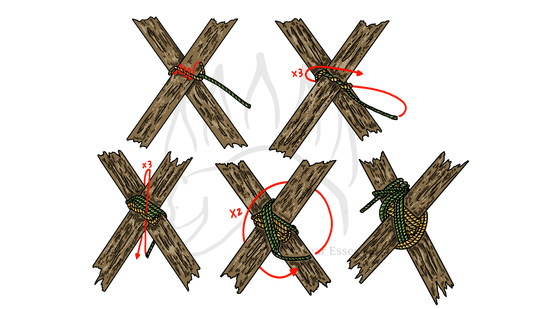How to Tie the Diagonal Lashing
Usage
The Diagonal Lashing is perfect for securing cross braces or stabilizing poles in outdoor structures. Ideal for angles between 45 and 90 degrees, it’s versatile enough for trestles, shelters, and other temporary frameworks. Its ability to close gaps between poles ensures reliable connections, making it a must-know for outdoor enthusiasts.
Why Learn the Knot
Mastering the Diagonal Lashing equips you with the ability to create secure and rigid connections. Whether you’re constructing a trestle for a bridge or adding cross braces to a shelter, this knot provides the reliability needed for structural integrity.
Common Uses
-
Pioneering and Scouting:
- Building trestles and other structural frameworks.
- Adding cross braces to prevent racking in larger structures.
- Outdoor Construction: Securing poles for temporary or semi-permanent shelters. Creating rigid wooden structures, such as fences or tripods.
- Emergency Applications: Stabilizing makeshift stretchers or bridges in survival scenarios.
ABOK Number
(Ashley Book of Knots)
Other Names
CategoryLashing Knot
|
Notable Features
- Adaptability: Works for poles crossing at various angles, from 45 to 90 degrees.
- Secure Hold: Frapping turns ensure the lashing remains tight and rigid.
- Gap Bridging: The initial Timber Hitch can pull poles together that do not initially touch.
Similar Knots
Transom Knot vs. Diagonal Lashing
- Pros of the Transom Knot: Simpler to tie and effective for temporary 90-degree connections.
- Cons: Less rigid and secure compared to Diagonal Lashing, especially for structural braces.
Square Lashing vs. Diagonal Lashing
- Pros of Square Lashing: Ideal for right-angle connections and more robust for permanent structures.
- Cons: Limited to 90-degree applications and less effective for angled poles or gap bridging.
Round Lashing vs. Diagonal Lashing
- Pros of Round Lashing: Excellent for connecting parallel poles side by side.
- Cons: Not suitable for cross-bracing or angular connections.
Tripod Lashing vs. Diagonal Lashing
- Pros of Tripod Lashing: Specially designed for three-pole connections to form stable tripods.
- Cons: Does not offer the same versatility for angled or crossing poles.
History
The Diagonal Lashing Knot is referenced in The Ashley Book of Knots as ABOK #2115 and has long been a staple in bushcraft and scouting projects. Its primary purpose is to provide rigidity to structures by closing gaps between crossed poles and preventing racking. This knot is frequently used in trestles, a foundational component of larger bushcrafting structures such as bridges and towers.
Security Level
The Diagonal Lashing Knot is highly secure when tied correctly. Frapping turns, which pull the lashing tightly around the poles, enhance its rigidity. While it is strong enough for semi-permanent structures, ensure the rope remains tight to prevent loosening over time.
Downsides
- Requires Precision: Proper tightening is critical for rigidity.
- Limited to Structural Bracing: Less versatile for non-crossed poles or parallel connections.
- Time-Intensive: Slightly more complex and time-consuming to tie compared to simpler lashings.
Structure
- Start with a Timber Hitch around the crossing point of the two poles.
- Make three to four wrapping turns along one diagonal axis, keeping the wraps parallel and tight.
- Repeat three to four wrapping turns along the opposite diagonal axis, again ensuring they are tight and parallel.
- Add two or three frapping turns between the poles to tighten the wraps.
- Finish with a Clove Hitch around one of the poles to secure the lashing.
Pro Tip: Use a lashing stick to help tighten the frapping turns for maximum rigidity.
FAQ
What is the Diagonal Lashing Knot used for?
It is used for securing crossed poles in structures, particularly when they do not initially touch or when the angle is not a perfect 90 degrees.
How secure is the Diagonal Lashing Knot?
When tied correctly, it is highly rigid and prevents racking in structural frameworks.
What tools can help with tightening the lashing?
A lashing stick or similar tool can assist in pulling the rope tight during frapping turns.
Can the Diagonal Lashing Knot be used for parallel poles?
No, it is specifically designed for crossed poles. Use a Round Lashing for parallel connections.
How does it compare to Square Lashing?
Diagonal Lashing is better suited for angled or gapped poles, while Square Lashing excels at right-angle connections.
Important Notes on Safety
The Diagonal Lashing Knot is a strong and reliable option for structural bracing but should always be checked for tightness during use. Ensure all wraps and frapping turns are secure to maximize the lashing’s rigidity and stability.









